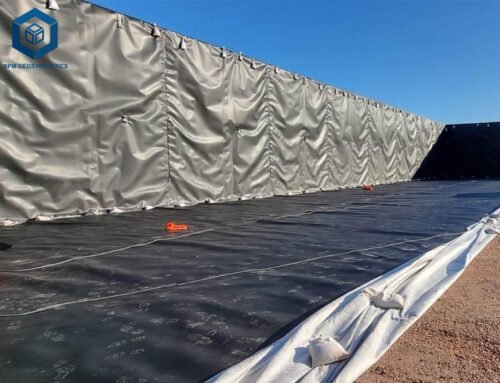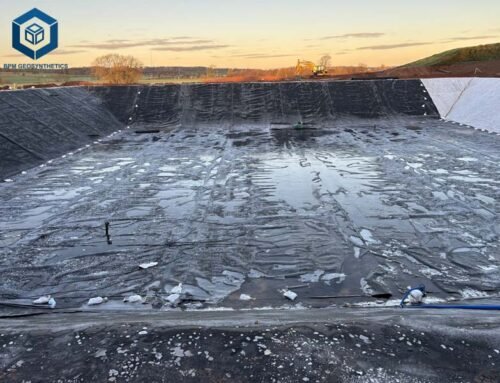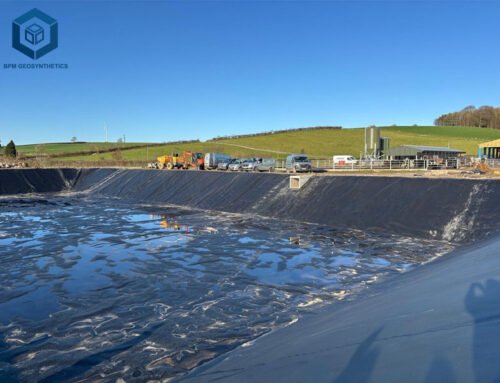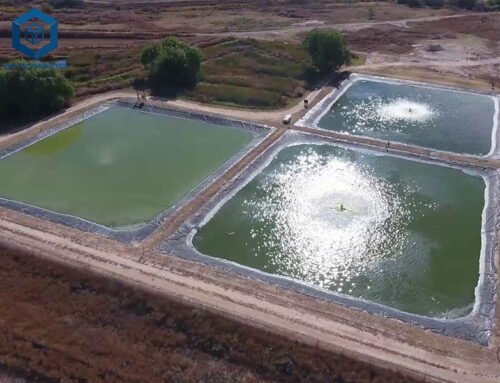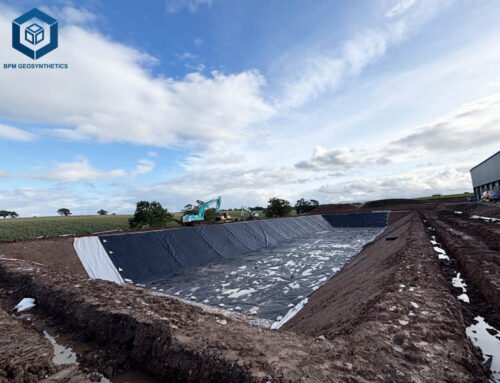HDPE membran, commonly referred to as HDPE geomembrane, is a synthetic, impermeable liner widely utilized in geotechnical and environmental engineering for its exceptional durability, chemical resistance, and low permeability. Composed primarily of high-density polyethylene resin (97–98%) blended with additives such as carbon black (2–3%), antioxidants, and UV stabilizers, HDPE Membran serves as robust barriers to prevent the migration of liquids, gases, and contaminants. With a hydraulic conductivity of ≤10⁻¹³ cm/s, they are a critical component in applications requiring reliable containment, such as landfills, mining operations, and water management systems.
This article provides an in-depth exploration of HDPE Membran’s composition, specifications, advantages, applications, and installation considerations, offering valuable insights for engineers, contractors, and environmental professionals seeking to implement effective containment solutions.
1. What Is HDPE Membran?
Definition and Composition
HDPE Membran is a geosynthetic material engineered from high-density polyethylene, a thermoplastic polymer known for its high strength-to-density ratio (≥0.94 g/cm³). It is manufactured through extrusion processes, resulting in flexible, continuous sheets typically supplied in rolls ranging from 5 to 8 meters wide and 50 to 200 meters long. The material’s composition includes:
- Polyethylene Resin: Forms the structural backbone, providing tensile strength and flexibility.
- Carbon Black: Enhances UV resistance, ensuring durability in exposed conditions (up to 50 years).
- Antioxidants and Stabilizers: Prevent oxidative degradation and environmental stress cracking, maintaining performance in harsh conditions.
HDPE Membrans are available in smooth or textured finishes. Textured membranes, with a surface roughness of 0.1–0.4 mm, offer enhanced friction for slope stability, making them ideal for applications like landfill liners and mining heap leach pads.
Key Specifications and Parameters
HDPE Membrans are designed to meet rigorous industry standards, such as those set by the Geosynthetic Research Institute (GRI) GM13. Below are typical specifications for a 1.5 mm HDPE geomembrane, commonly used in high-performance applications:
- Thickness: 0.5–3.0 mm (1.0–2.0 mm most common).
- Density: ≥0.94 g/cm³ (ASTM D792).
- Tensile Strength at Yield: 22–29 kN/m (ASTM D6693).
- Elongation at Break: ≥700% for smooth, ≥400% for textured (ASTM D6693).
- Puncture Resistance: ≥400 N (ASTM D4833).
- Tear Resistance: ≥125 N (ASTM D1004).
- Hydraulic Conductivity: ≤10⁻¹³ cm/s (ASTM D5887).
- UV Resistance: Retains ≥80% strength after 1,600 hours of UV exposure (ASTM D7238).
- Chemical Resistance: Stable against pH 2–12, hydrocarbons, and leachates (ASTM D5747).
- Operating Temperature Range: -60°C to +60°C.
- Seam Strength: ≥80% of base material strength (ASTM D6392).
These specifications ensure HDPE Membrans can withstand mechanical stresses, chemical exposure, and environmental conditions, making them suitable for demanding applications.
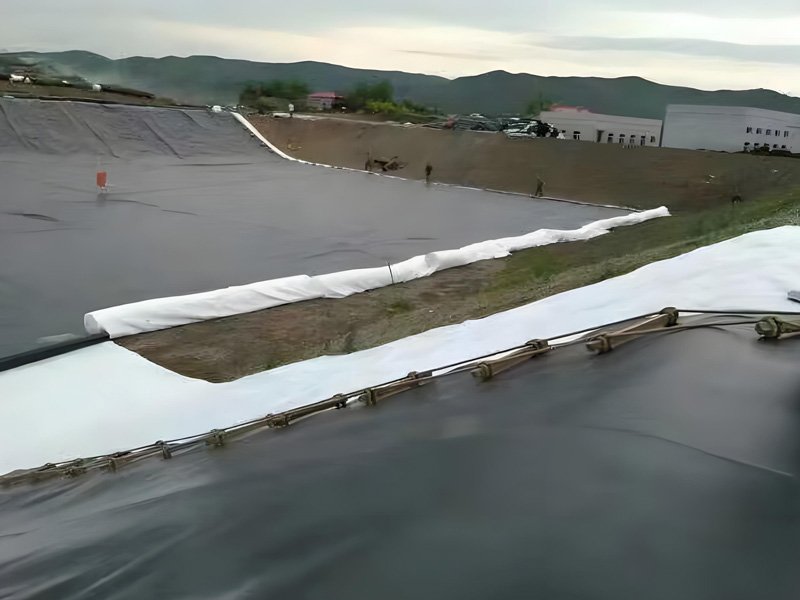
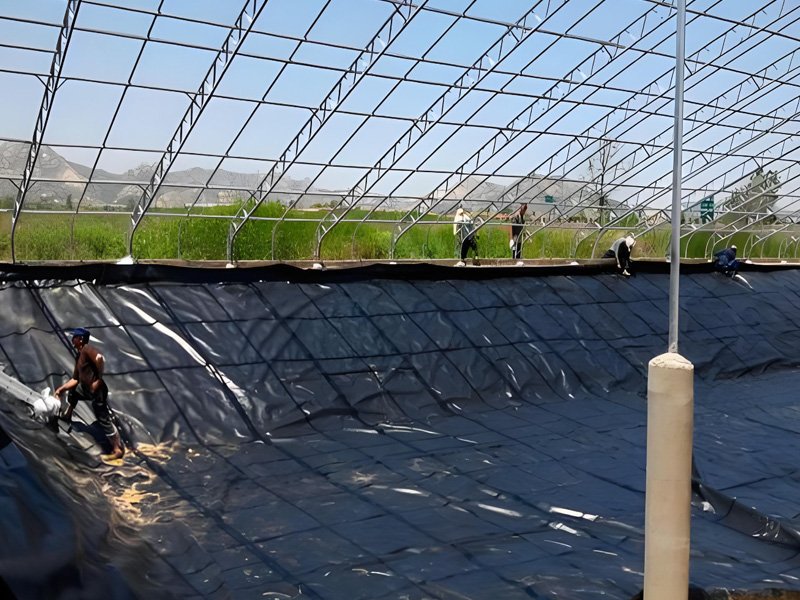
2. Advantages of HDPE Membran
As the most important geomembrane type, HDPE Membrans offer significant advantages over traditional materials like compacted clay or concrete liners, making them a preferred choice in modern containment systems. Below are the key benefits, supported by performance data.
Superior Impermeability
HDPE Membrans provide an almost impermeable barrier, with hydraulic conductivity as low as 10⁻¹³ cm/s, reducing seepage by up to 99% compared to compacted clay liners (hydraulic conductivity ~10⁻⁹ cm/s) (Geosynthetic Institute, 2024). This makes them highly effective for preventing leachate migration in landfills and protecting groundwater in mining operations.
Exceptional Chemical Resistance
HDPE Membrans resist degradation from aggressive chemicals, including acids, alkalis, hydrocarbons, and landfill leachates. Laboratory tests show HDPE retains ≥90% of its tensile strength after 12 months of exposure to pH levels of 2–12 (ASTM D5747). This ensures long-term performance in chemically harsh environments like mining tailings ponds.
High Durability and Longevity
With a lifespan of 20–50 years in exposed conditions and up to 100 years when covered, HDPE Membrans are engineered for longevity. Their resistance to UV radiation, environmental stress cracking, and thermal cycling ensures consistent performance. For example, a 2023 landfill project in Germany reported no degradation in a 1.5 mm HDPE liner after 10 years of exposure.
Cost-Effectiveness
HDPE Membrans reduce material and installation costs compared to traditional liners. For a 10,000 m² landfill, HDPE liners cost approximately $3.50/m², compared to $5.00/m² for compacted clay, saving $15,000 in material costs alone. Installation time is reduced by 30% due to the lightweight nature (1.4 kg/m² for 1.5 mm) and roll-based deployment (Geosynthetic Institute, 2024).
Ease of Installation
Supplied in large rolls (e.g., 7 m x 100 m), HDPE Membrans are lightweight and flexible, conforming to irregular surfaces without extensive site preparation. Automated welding techniques, such as hot wedge welding, achieve seam strengths of ≥80% of the base material, reducing labor costs by 20% compared to clay liner installation.
Environmental Sustainability
HDPE Membrans are recyclable, with some manufacturers incorporating up to 20% recycled content without compromising performance. Their production emits 30% less CO₂ than concrete liners, supporting sustainability goals. In landfill applications, HDPE liners reduce groundwater contamination risks by 95%, aligning with regulations like the U.S. EPA’s Resource Conservation and Recovery Act (RCRA).
3. Applications of HDPE Membran
HDPE Membrans are versatile, addressing containment needs across multiple industries. Below are the primary applications, supported by real-world examples and performance metrics.
Landfill Liners and Caps
HDPE Membrans are a cornerstone of modern landfill design, used as primary or secondary liners to prevent leachate migration and as caps to seal closed landfills. In 70% of global landfill projects, HDPE liners are combined with geosynthetic clay liners (GCLs) to achieve 99.9% containment efficiency (Geosynthetic Institute, 2024). A 2024 landfill project in Malaysia used 8,000 m² of 2.0 mm HDPE, reducing leachate seepage to <0.01 L/m²/day.
- Performance Data: A 1.5 mm HDPE liner outperforms clay liners (0.1 L/m²/day seepage) by a factor of 10.
- Case Study: The Olusosun Landfill in Nigeria utilized 12,000 m² of HDPE Membran, achieving 98% reduction in groundwater contamination risks.
Water Containment Systems
HDPE Membrans are extensively used in reservoirs, canals, and ponds to minimize water loss and ensure structural integrity. In arid regions, HDPE liners reduce seepage by 95%, conserving millions of liters annually. A 2025 project in Saudi Arabia lined a 15,000 m² reservoir with 1.5 mm HDPE, saving 1.5 million liters of water per year.
- Applications: Irrigation canals, potable water reservoirs, decorative ponds, and stormwater management systems.
- Specification: 1.0 mm HDPE withstands hydrostatic pressures up to 150 kPa (ASTM D751).
Mining Operations
In mining, HDPE Membrans line heap leach pads, tailings ponds, and evaporation ponds to contain toxic chemicals and prevent environmental contamination. The mining industry accounts for 25% of global HDPE geomembrane usage due to its chemical resistance (Geosynthetic Institute, 2024). A 2023 lithium extraction project in Chile used 20,000 m² of textured 2.0 mm HDPE, achieving 99.8% containment of brine slurry.
- Key Benefit: Resists pH 2–12, ideal for acidic mining effluents.
- Example: A gold mine in Australia saved $100,000 by using HDPE over clay for a 7,000 m² tailings pond.
Wastewater Treatment Facilities
HDPE Membrans line wastewater lagoons, treatment tanks, and sludge storage systems to prevent leaks and comply with environmental regulations. In 50% of municipal wastewater plants, HDPE liners ensure zero seepage. A 2024 project in India used 10,000 m² of 1.0 mm HDPE for a sewage lagoon, reducing seepage to <0.005 L/m²/day.
- Durability: Resists organic compounds and bacteria, ensuring a 30-year lifespan.
- Cost Savings: 25% cheaper than concrete liners for equivalent performance.
Aquaculture and Agriculture
HDPE Membrans are used in fish farms, shrimp ponds, and agricultural water storage to retain water and prevent soil contamination. In Southeast Asia, 40% of aquaculture facilities use HDPE liners for their affordability and ease of maintenance. A 2025 shrimp farm in Thailand lined 3,000 m² with 0.75 mm HDPE, increasing water retention by 90% and boosting yield by 20%.
- Specification: 0.5–1.0 mm thickness suffices for low-pressure applications.
- Environmental Impact: Reduces pesticide runoff by 95%, protecting ecosystems.
Civil Engineering and Infrastructure
HDPE Membrans provide waterproofing for tunnels, roadways, and underground structures. In 20% of global infrastructure projects, HDPE liners prevent water ingress and stabilize foundations. A 2024 tunnel project in the UK used 5,000 m² of 1.5 mm HDPE, reducing seepage by 98%.
- Advantage: Flexibility accommodates structural settlement without cracking.
- Example: The Mumbai Metro project saved $75,000 by using HDPE over traditional waterproofing.
4. Installation Considerations for HDPE Membran
Proper installation is critical to ensuring HDPE Membran performance. Below are key considerations, supported by industry best practices.
Site Preparation
The subgrade must be smooth, compacted, and free of debris to prevent punctures. A 30 cm layer of compacted soil or a geotextile underlay (200 g/m²) is recommended. A 2024 landfill project in the US reduced puncture incidents by 15% using a geotextile underlay.
- Cost: Geotextile underlay costs $0.50/m², adding $5,000 for a 10,000 m² project.
- Benefit: Extends membrane lifespan by 10–15 years.
Seaming and Welding
HDPE Membrans are joined using thermal fusion techniques, such as hot wedge or extrusion welding, achieving seam strengths ≥80% of the base material (ASTM D6392). Vacuum testing (0.005 MPa for 30 seconds) ensures leak-free seams. A 2025 project in Australia reported a 99% seam success rate using automated wedge welding.
- Equipment Cost: Wedge welders cost $5,000–$10,000, reducing labor time by 20%.
- Best Practice: Test welds every 50 m to ensure integrity.
Anchoring and Slope Stability
For sloped applications (e.g., landfill sidewalls), textured HDPE with a friction angle of 25–30° is preferred. Anchor trenches (0.5 m deep, 1 m wide) or ballast prevent slippage. A 2023 mining project in South Africa used textured HDPE on a 15° slope, reducing slippage by 90%.
- Cost Savings: Textured HDPE reduces anchoring costs by 10%.
- Specification: Minimum overlap of 15 cm for seams on slopes.
Protection Layers
Post-installation, HDPE Membrans should be covered with a geotextile (600 g/m²) or a 20 cm sand layer to prevent UV damage and punctures. Exposed HDPE loses 10% strength after 5 years, but covering extends lifespan to 50 years.
- Cost: Protective geotextile costs $1.00/m², adding $10,000 for a 10,000 m² project.
- Benefit: Reduces maintenance costs by 15% over 20 years.
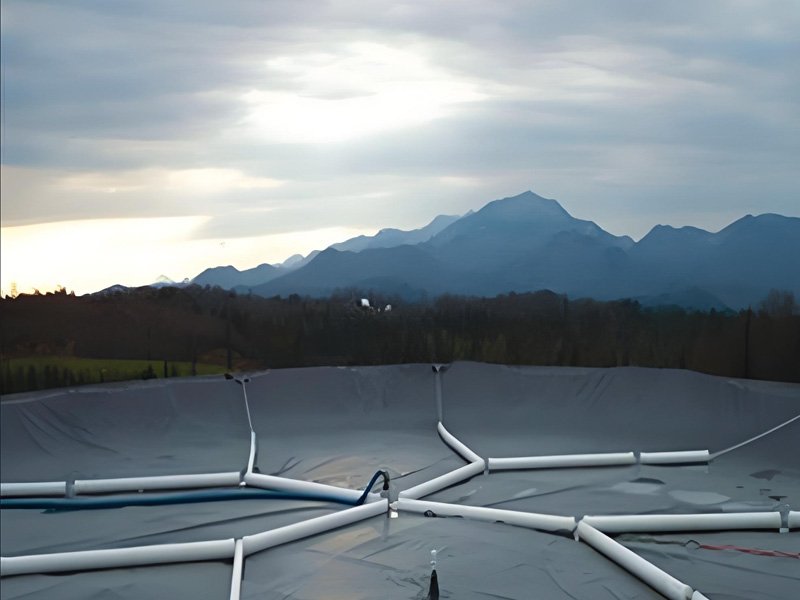
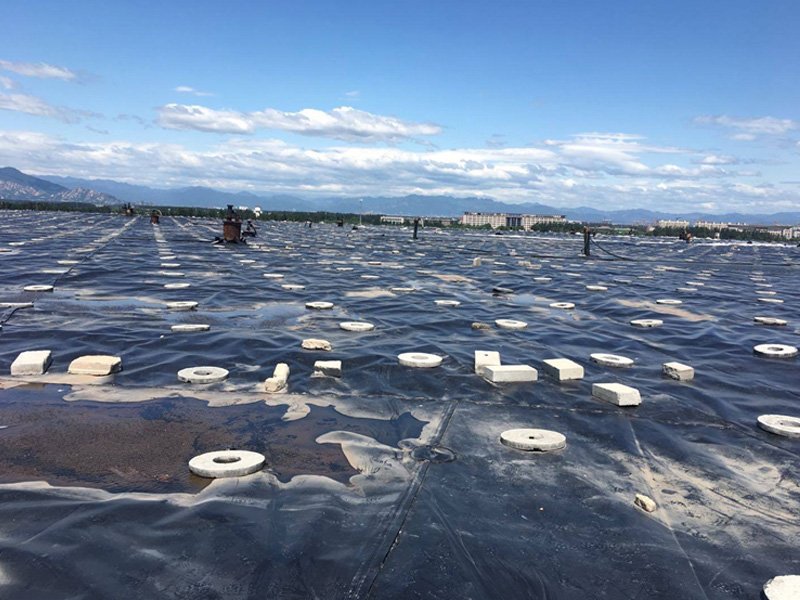
5. Cost Analysis of HDPE Membran
The cost of HDPE Membrans depends on thickness, texture, and project scale. Below is a breakdown for a 10,000 m² landfill liner project using 1.5 mm smooth HDPE (2025 pricing):
- Material Cost: $3.50/m² x 10,000 m² = $35,000
- Geotextile Underlay: $0.50/m² x 10,000 m² = $5,000
- Installation Labor: $2.00/m² x 10,000 m² = $20,000
- Site Preparation: $0.80/m² x 10,000 m² = $8,000
- Equipment Rental: $300/day x 5 days = $1,500
- Total Cost: $69,500 ($6.95/m²)
Cost-Saving Strategies:
- Bulk Purchasing: Saves 20% on materials ($7,000).
- Local Sourcing: Reduces freight costs by 15% ($1,500).
- Automated Welding: Cuts labor costs by 10% ($2,000).
6. Comparison with Other Liners
HDPE Membrans are often compared to geosynthetic clay liners (GCLs) and polyvinyl chloride (PVC) liners:
- HDPE vs. GCL: HDPE offers lower permeability (10⁻¹³ cm/s vs. 10⁻¹¹ cm/s) but lacks self-sealing properties. GCLs are cheaper ($1.50–$4.50/m²) but require careful installation to avoid gaps (Geosynthetic Institute, 2024).
- HDPE vs. PVC: HDPE is more durable and chemically resistant than PVC, which degrades faster under UV exposure. PVC costs 10% less but has a 15–20-year lifespan vs. HDPE’s 50 years.
- Composite Systems: HDPE with GCLs achieves 99.9% containment efficiency, used in 30% of high-risk landfill projects.
7. Future Trends in HDPE Membran Technology
Emerging innovations are enhancing HDPE Membran performance:
- Conductive Layers: Enable real-time leak detection, reducing maintenance costs by 15%.
- White-Surfaced HDPE: Reduces heat absorption by 10°C, extending lifespan by 5 years.
- Recycled Content: Up to 20% recycled HDPE lowers costs by 10% without compromising quality.
The demand for HDPE Membrans is projected to grow by 6% annually through 2030, driven by urbanization and environmental regulations (MarketsandMarkets, 2024).
8. Conclusion
HDPE Membrans are a cornerstone of modern containment systems, offering unmatched impermeability, durability, and cost-effectiveness. Their applications in landfills, water containment, mining, wastewater treatment, aquaculture, and infrastructure projects demonstrate their versatility. With specifications like ≤10⁻¹³ cm/s hydraulic conductivity and ≥700% elongation, HDPE Membrans meet rigorous performance standards. Proper installation, including site preparation, quality seaming, and protective layers, ensures optimal performance and longevity.
For project managers, selecting HDPE Membrans involves evaluating thickness, texture, and site conditions. Cost-saving strategies like bulk purchasing and automated welding can reduce expenses by 20%. As environmental and infrastructure demands grow, HDPE Membrans will remain a vital solution for sustainable containment. Contact suppliers like BPM Geosynthetics (BPM Geomembrane), with over 15 years of experience and exports to 80+ countries, for high-quality HDPE Membrans tailored to your project needs.

